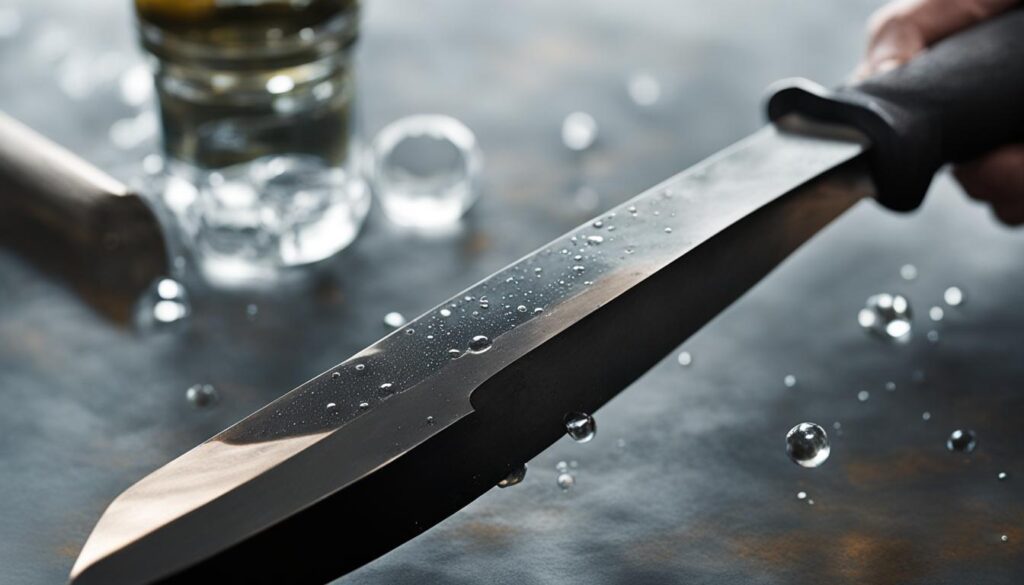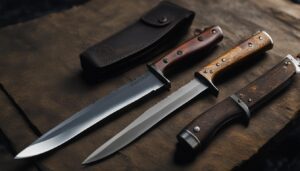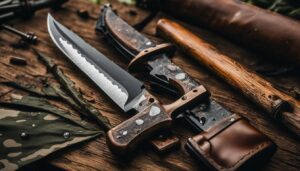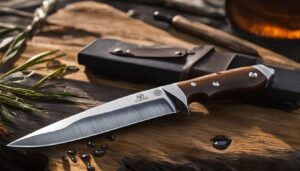Steel knives, including carbon steel and stainless steel, are prone to rust due to their composition. High carbon knives have a higher carbon content and less chromium, making them more susceptible to rust. Stainless steel knives have a higher chromium content, providing some protection against corrosion. However, with abuse or lack of care, even stainless steel knives can rust. Rust is the reddish-brown buildup that occurs when iron in the steel reacts with oxygen and water. It can destroy the blade if left unchecked.
On the other hand, a patina, which is a yellowish color developed through exposure to air and moisture, can actually protect the surface of a carbon steel blade from rust. To prevent rust on hunting knives, techniques such as Parkerizing and Cerakote coatings are used to enhance rust resistance. Additionally, proper cleaning, waxing, and drying of the blade, as well as caring for the sheath, can help prevent rust. Using an appropriate oil or wax, such as MKC blade wax, is also recommended for rust prevention. Saltwater exposure is particularly harsh on knives, so using stainless steel blades or implementing MagnaCut stainless steel is advised in such conditions.
Key Takeaways:
- Steel knives, including carbon steel and stainless steel, are prone to rust due to their composition.
- A patina, developed through exposure to air and moisture, can protect the surface of a carbon steel blade from rust.
- Techniques like Parkerizing and Cerakote coatings enhance rust resistance on hunting knives.
- Proper cleaning, waxing, and drying of the blade, as well as caring for the sheath, can help prevent rust.
- Using an appropriate oil or wax, such as MKC blade wax, is recommended for rust prevention.
- Saltwater exposure is harsh on knives, so using stainless steel blades or MagnaCut stainless steel is advised.
Understanding Different Types of Steel and Rust Issues
Hunting knives are commonly made from two types of steel: high carbon steel and stainless steel. Each type of steel has its own composition and characteristics, which can affect its susceptibility to rust and corrosion.
Carbon Steel: High carbon steel knives have a higher carbon content and less chromium, making them more prone to rust and corrosion. While carbon steel knives are often harder and easier to sharpen, they require more attention and care to prevent rust. Without proper maintenance, carbon steel knives can quickly develop rust and corrosion.
Stainless Steel: Stainless steel knives, on the other hand, have a higher chromium content, providing better resistance against rust. The presence of chromium in stainless steel creates a protective layer that helps prevent oxidation and corrosion. However, it is important to note that stainless steel knives are not entirely immune to rust and corrosion. With abuse or lack of care, stainless steel knives can still develop rust.
Regular cleaning and maintenance are essential for preventing rust formation on both types of steel. By understanding the composition of the steel used in a hunting knife, hunters can take the necessary preventive measures to ensure their knives remain rust-free and in optimal condition.
Comparison of Carbon Steel and Stainless Steel
| Characteristics | Carbon Steel | Stainless Steel |
|---|---|---|
| Composition | Higher carbon content, less chromium | Higher chromium content |
| Hardness | Harder, easier to sharpen | Varies depending on specific alloy |
| Rust Resistance | Prone to rust and corrosion without proper care | Better resistance against rust, but not entirely immune |
| Maintenance | Requires regular cleaning, drying, and oiling/waxing | Requires regular cleaning, drying, and occasional oiling/waxing |
Understanding the characteristics of the different types of steel used in hunting knives can help hunters make informed decisions about care and maintenance. By implementing proper cleaning techniques and regular maintenance, rust formation can be prevented, ultimately prolonging the life of the hunting knife.
Effective Cleaning and Maintenance Techniques
Proper cleaning and maintenance are essential for preventing rust on hunting knives. By following these techniques, you can ensure that your knives remain in pristine condition and have a longer lifespan.
Cleaning Knives
After each use, it is important to wash the blade with soapy water and thoroughly dry it before storing. This helps remove any dirt or residue that may accumulate on the blade. Pay close attention to cleaning the knife if it has been used to cut acidic materials like onions, as these can cause steel to rust quickly. An alternative cleaning method is to use a cleaning solution specifically designed for knives. These solutions are formulated to remove dirt and prevent rust formation.
Lubrication
Regularly applying lubricant to the blade can help prevent rapid rust formation, especially when the knife is inactive for a period of time. Lubricants create a protective barrier that shields the steel from moisture and oxygen, which are the main culprits behind rust. There are various types of lubricants available, such as mineral oil, silicone-based lubricants, and specialty knife oils. Apply a small amount of lubricant to the blade and distribute it evenly using a clean cloth or your fingers.
Sharpening
When rust appears on the blade’s edge, it is essential to sharpen the knife to remove it and restore the edge. Regular sharpening not only keeps the blade in optimal cutting condition but also helps to remove any surface rust that may have formed. You can use sharpening stones, honing rods, or electric sharpeners to maintain a sharp edge. It is important to follow the manufacturer’s instructions and use the appropriate technique for sharpening your specific type of knife.
Summary
In conclusion, to prevent rust on hunting knives, it is crucial to clean the blade thoroughly after each use and dry it completely before storing. Additionally, lubrication helps protect the blade from moisture and oxygen, while regular sharpening removes any rust and keeps the knife in optimal condition. By following these effective cleaning and maintenance techniques, you can prolong the life of your hunting knives and ensure they are always ready for use.
How to Force a Patina on Carbon Steel Knives
Carbon steel knives are known for their susceptibility to rust, but there is a method to create a protective layer and prevent rust formation. By forcing a patina on carbon steel knives, you can enhance their resistance to corrosion, ensuring their longevity. One popular method to force a patina is by using coffee.
To create a patina using coffee, begin by placing the knife blade in a tall vessel containing brewed and chilled coffee. The length of time required for the patina to form may vary depending on the desired result. After the desired time has passed, remove the knife from the coffee and wipe it down with a damp cloth. Finally, ensure the knife is thoroughly dried to prevent any residual moisture from causing rust.
It’s important to note that forcing a patina can alter the appearance of the knife permanently. If you prefer the current look of your knife, it may be best to let the patina develop naturally over time. However, if you are open to a unique and protective finish, the coffee method can be an effective solution for preventing rust on your carbon steel knives.

Forcing a Patina with Coffee Method:
| Materials: | Instructions: |
|---|---|
| – Carbon steel knife | 1. Brew a fresh pot of coffee and let it cool. |
| – Freshly brewed and chilled coffee | 2. Place the knife blade in a tall vessel containing the coffee. |
| – Tall vessel | 3. Allow the knife to soak in the coffee for the desired amount of time. |
| – Damp cloth | 4. Remove the knife from the coffee and wipe it down with a damp cloth. |
| – Thoroughly dry the knife | 5. Ensure the knife is thoroughly dried to prevent moisture-induced rust. |
Conclusion
Proper care and maintenance are essential for ensuring the longevity of hunting knives. By implementing effective rust prevention tips, you can prolong the life of your blade and optimize its performance. Cleaning the blade thoroughly after each use and drying it completely helps prevent rust formation. Consider applying a protective layer of wax, such as MKC blade wax, to enhance rust resistance.
Additionally, applying lubricant to the blade when the knife is not in use further enhances its ability to resist rust. For carbon steel knives, forcing a patina can provide an extra layer of protection against corrosion. Paying attention to the steel composition of your knife and understanding its susceptibility to rust are crucial steps in preventing damage.
When using your hunting knife in saltwater environments, it is advisable to opt for stainless steel blades or MagnaCut stainless steel, as these materials are more resistant to corrosion. By following these rust prevention tips and techniques, you can ensure that your hunting knife remains in optimal condition and reliably serves you for years to come.
FAQ
Why are steel knives prone to rust?
Steel knives, including carbon steel and stainless steel, are prone to rust due to their composition. Rust occurs when iron in the steel reacts with oxygen and water, resulting in a reddish-brown buildup that can destroy the blade if left unchecked.
Do high carbon steel knives rust more than stainless steel knives?
Yes, high carbon steel knives have a higher carbon content and less chromium, making them more susceptible to rust. Stainless steel knives have a higher chromium content, providing some protection against corrosion.
Can stainless steel knives rust?
While stainless steel knives have better resistance against rust due to their higher chromium content, they can still rust with abuse or lack of care.
What is the difference between rust and a patina?
Rust is a reddish-brown buildup that occurs when iron in the steel reacts with oxygen and water, while a patina is a yellowish color developed through exposure to air and moisture. A patina can actually protect the surface of a carbon steel blade from rust.
How can I prevent rust on hunting knives?
Techniques such as Parkerizing and Cerakote coatings can enhance rust resistance on hunting knives. Additionally, proper cleaning, waxing, and drying of the blade, as well as caring for the sheath, can help prevent rust. Using an appropriate oil or wax, such as MKC blade wax, is also recommended for rust prevention. In harsh saltwater conditions, using stainless steel blades or implementing MagnaCut stainless steel is advised.





